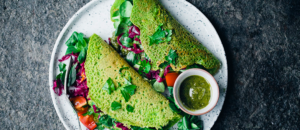Thin Stuffed Pancakes with Fresh Herb Filling
Why I Make These So Often
You know that feeling when you’re hungry but don’t want anything heavy? That’s when I make these thin pancakes filled with a bright, herby mix. I’ve been cooking professionally for years, but some of my favorite dishes are the ones I grew up with — and then slowly made my own. These remind me of the Eastern European blini I had as a kid, but with a California garden twist.
They’re light, they’re flexible, and they somehow manage to feel comforting and fresh at the same time. I serve them for brunch, for lunch, even as an appetizer with a chilled white wine. And every time someone says “What’s in this?”, it’s always the herbs that hook them.

What You’ll Need
The pancake itself is more of a crepe: super thin, almost lacy, but sturdy enough to hold a filling. I use just four ingredients — flour, eggs, milk, a touch of oil — and sometimes sneak in a pinch of nutmeg if I’m feeling fancy.
As for the filling? For me, it’s all about herbs. I use whatever’s growing: parsley, scallions, dill, chives. If I’m hosting brunch, I’ll add a bit of crumbled feta or ricotta to the mix. If it’s just me on a Tuesday, I skip the cheese and it’s still wonderful.
Here’s How I Do It
I whisk the batter in the morning — 1 cup flour, 2 eggs, about 1 ¼ cups of milk, a splash of oil, and a pinch of salt. That sits for 20–30 minutes while I chop herbs and get the coffee going.
I warm a nonstick skillet, pour in a ladle of batter, swirl, wait till it looks set, then flip. They cook fast — 90 seconds per side, tops. I stack them under a clean towel so they stay warm and pliable.
Meanwhile, I sauté the herbs just until they wilt. No need to overdo it. Then I spoon that mixture into the pancakes, fold, and either serve right away or brown them lightly again in the pan if I want that golden crust.
What Makes Them Special
Honestly? It’s the simplicity. The filling tastes green and alive, the pancake is soft and just barely eggy, and you don’t feel like you need a nap afterward. When I want comfort without heaviness, this dish hits the mark every time.
They’re also great cold — I’ve wrapped them for hikes, picnics, and even eaten them one-handed while driving (not recommended, but true).
My Favorite Variations
- Add crumbled feta and lemon zest to the filling — tangy and fresh.
- Throw in a handful of spinach or arugula if you’re low on herbs.
- Use ricotta for a more filling, creamy version.
Quick Nutrition Breakdown (Per 2 pancakes with herbs and feta)
| Nutrient | Approximate Value |
|---|---|
| Calories | ~220 kcal |
| Protein | 9–11 g |
| Fat | 11–13 g |
| Carbs | 18–20 g |
| Fiber | 2 g |
| Sodium | 280–320 mg |
Final Thoughts
I’ve cooked for crowds and plated dishes with tweezers, but when I want something real — something that feeds both the stomach and the soul — I make these. They’re humble, but never boring. Fresh, but not fussy. And every bite tastes like home, no matter where you’re from.
FAQ – Thin Herb-Stuffed Pancakes
Can I use dried herbs instead of fresh?
You can, but the flavor won’t be nearly as bright. If you must, reduce the amount to 1/3 and hydrate them briefly in warm water before adding.
My crepes keep tearing. What am I doing wrong?
Usually, the batter is too thick or the pan isn’t hot enough. Let the batter rest 30 minutes, then make sure your skillet is properly preheated.
Can I make the batter the night before?
Absolutely. Just cover and refrigerate. Stir it gently before using — it may thicken, so you can loosen it with a splash of milk.
Are these gluten-free?
Not by default, but you can swap the flour for a 1:1 gluten-free blend. Avoid almond or coconut flour unless you’re familiar with crepe adjustments.
Can I make them dairy-free?
Yes. Use plant-based milk (like oat or soy) and a neutral oil instead of butter. The taste will still be great, especially with a bold herb filling.
How do I reheat leftovers?
Warm them gently in a skillet or low oven. I don’t recommend microwaving — it makes them soggy. A dry pan is best for a crisp finish.
Can I freeze them?
Yes, stack with parchment between each, wrap tightly, and freeze. Defrost overnight and reheat in a dry pan for best texture.
What’s the best pan for making crepes?
A good-quality nonstick skillet or traditional crepe pan. Keep the surface lightly oiled and wipe between batches.
Are they kid-friendly?
Surprisingly, yes — if you go easy on bitter herbs like parsley. Add a bit of cheese or soft scrambled eggs for picky eaters.
Can I make a big batch and keep them warm?
Yes. Layer cooked crepes on a plate, cover with foil or a towel, and keep in a low oven (around 200°F) until serving time.
What protein goes well with this?
Feta or ricotta are great. You can also add soft-boiled egg halves, smoked salmon, or even chopped cooked chicken for a fuller meal.
How do I serve them for guests?
I like to roll and slice them on a platter, drizzle with a little olive oil or yogurt sauce, and sprinkle with extra herbs. Simple, elegant, and always eaten fast.


Post Comment